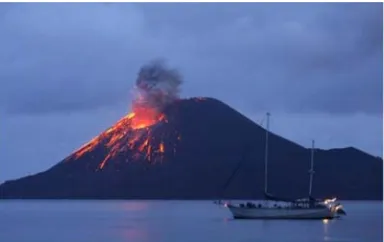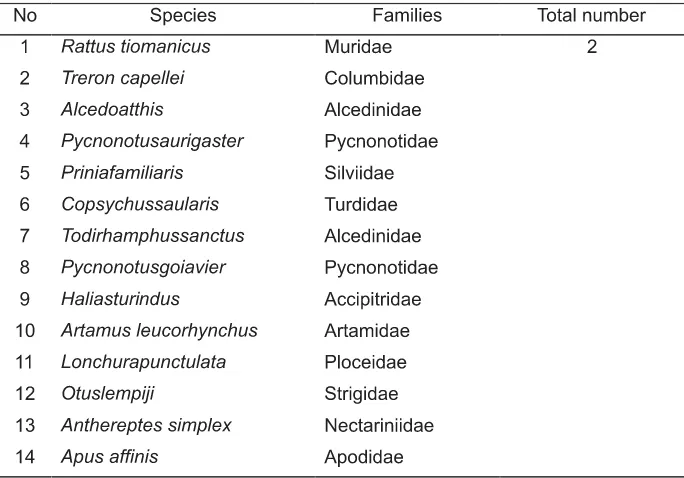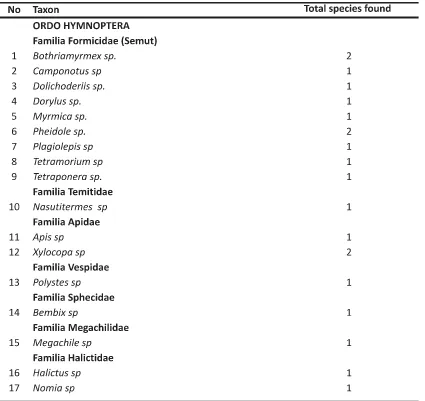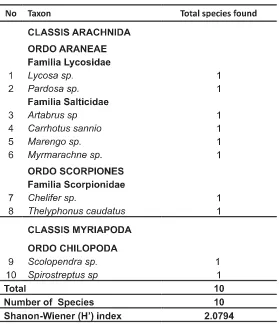RECENT BIODIVERSITY IN ANAK KRAKATAU ISLAND
A.S. Rikha1, E. L. Widiastuti2, N. Nurcahyani2, M. Kanedi2
1 Nature Conservation Agency of Lampung (BKSDA II), 2 Biology Dept of University of Lampung Email:1[email protected],2 [email protected]
ABSTRACT
Anak Krakatau Island is a volcanic island in the Krakatau preservation complex. With its regular explosions, ranging from2 80 times/day in the year 2013, it was expected that the biodiversity would experience many changes. In orderto determine the recent condition of the biodiversity, especially animal inhabitants, a survey was conducted within the island in June, 2013. The survey was made for mammal, bird, reptile, and invertebrate(ground, aerial, and arboreal) diversity. For mammals, 10 live traps were used along 100 m of line transect, birds and reptiles were adopted faced encountered method, while the invertebrate survey was conducted with visual techniques with a sweep net, pit-fall traps, and light traps. The result from the inventory (especially invertebrate) was followed by determining the diversity and dominance of species. Relative abundancewas also determined for mammals only. The survey indicated that there was 1 species of mammal with 20% of relativeabundance, 13 species of birds within 11 families, 2 species of reptiles, 58 species of insect, and 10 species of non-insect invertebrates, which consisted of 6 species of Araneae, 2 species of Scorpiones, 2 species of Chilopoda. The diversity indexfor insects was 4.011 with Bothriamyrmex sp. as subdominantin which its index of 2.86, and index for non-insects was 2.079. The result also was compared with the other 3 islands of the Krakatau complex and data collected in the last 10 years.
Key words: Anak Krakatau, volcanic, biodiversity
INTRODUCTION
Anak Krakatau Island emerged from the seawater around 1927,Since then, it has grown, reaching the height of more than 450 m. It is the only volcanicislandamong four islands of the Krakatau preservation complex. The Anak Krakatau has shown regular eruptions, in this year (2013) its eruptionranging from 2–80 times/day, and much more eruptions in the last year, especially on 2nd September, 2012, in which the eruption reacheda height of more than
500 m. With its regular eruptions every year,it may be expected that the terrestrial biodiversity of the island would experience many changes.Many of the eruptions contained dust and particles. The total area of Anak Krakatau Island was 320 ha, and only 10% was occupied by living organisms. In order to determine the biodiversity of the Anak Krakatau Island, a survey was made on June 2013, especially for animal inhabitants.
Figure 1. Anak Krakatau island in the complex of Krakatau islands.
ISSN 2413-0877 © 2015 The Authors.
Published by KnowledgeE Publishing Services This is an open access article under the CC BY-NC-ND license (http://creativecommons.org/licenses/by-nc-nd/4.0)
ISSN 2413-0877 Volume 2 (2015) 245-252
MATERIALS AND METHODS
A. Inventory made for small mammals
The small mammal inventory was made only for terestrial mammals. Live traps (10) were placed along a100 m line transect. Each trap was baited with coconut and salty fish. The captured animals were identified by its characteristics and species before being re-leased. It was followed by determining the diversity and dominance of species. Relative abundance was also determined but only for mammals, using modified Cox’s (1996), such as,
RA = [ni/T] x 100% RA : Relative abundance
ni : number of trapped individuals N : number of traps
B. Inventory made for birds (avian) and reptiles
Face encountered method and visual techniques, as well as observation with binocu-lars was used for this inventory.
C. Inventory made for Invertebrates
The inventory was made intentionally for ground animals, included aerial and arboreal. The methods were used beside visual with face encountered method, trapping and netting were also employed. Visual face encountered was applied for invententoring birds, reptiles, and macro-invertebrates such as Papilionida, Orthoptera, Myriapoda, and Arachnida. Trap-pings were made for small/micro-invertebrates, such as by using asweep net,pit fall traps, and light traps. Trapped animals were preserved in 70% alcohol for further laboratory identi-fication, which was conducted in the Zoological Lab of University of Lampung. Collected animalswere then determined for their diversity index of Shannon-Wiener, Sorensen index (similarity index), and domination index based on Cox’s methods (1996).
Diversity indexof Shannon-Wiener was based on: In which:
ni : individual number of species i N : total species in the area Ln : natural log
Dominant index of Cox’s (1996):
Di : Dominant index of species i Pi : portion of species i
ni : number of species i N : total number
Species dominant of the community in the area study then was grouped based on Jorgenssen’s criteria, such as dominant (Di> 5%), subdominant (Di = 2% – 5 %), nondominant (Di< 2%) .
RESULT AND DISCUSSION
Mammals and birds found in the island can be seen in Table 1.
Table 1. Mammal and avian species found in Anak Krakatau Island
Only one species of rat was found in Anak Krakatau, it was part of Muridae family - Ordo Rodentia. This species of rat was also identified by Thornton (1996). Comparedwith other islands (data was not shown), the relative abundance of the rat found in Anak Krakatau is-land was 20%. The existing of this mammal was not away from any human activity, in this case in tourism, in which during the weekend, between 5–10 boats carried approximately 20 people per day to Anak Krakatau Island.
We found 13 species of bird in Anak Krakatau from 11 families. The number of birds differed slightly from a previous study conducted in April, 2012 (Martin, 2012) prior to the huge eruption of Anak Krakatau on September 2nd, 2012. It was expected that the migration
of birds might take place on Anak Krakatau in that period.
Only two reptiles were found, Varanus salvator and Eretmochelys imbricata. This turtle was found laying its eggs on the beach of Anak Krakatau Island.
total of 70 individuals and the Shannon-Wiener (H’) index of 4.011(Table 2). Krakatau Island consisted of 4 different islands; comparedwith the other three different islands(data wasnot shown) species of Bothriamyrmex sp.in Anak Krakatauwas considered to be subdominant with its index of 2.86. The number of species found was different from early studies; 40 different species of butterfly was found in the year 1992 (New & Thornton, 1992), and 30 species of beetles was also found in 2010 (Williams & Miller, 2010). Presumably, regular eruptions of Anak Krakatau which mainly consisted of dust and hot particles affected the total species found in this year (2013).
Arthropods non-insect found in Anak Krakatau Island
From our survey/inventory of arthropods non-insect in Anak Krakatau Island we found 21 species. They consisted of 6 species of Araneae, 2 species of Scorpiones, and 2 species of Chilopods with the diversity index (Shannon-Wiener (H’) Index) of 2.079 (Table 3). All of the total number of species that we found was significantly lower than the number species found by Zabka & Nentwig (2000). They claimed that they found at least 33 species of Araneae. However, the species found for Scorpiones and Chilopods were not different com-pared with those reported by Thornton (1996).
Table 3. Arthropod diversity found in Anak Krakatau (2013)
CONCLUSION
The animal diversity found in Anak Krakatau Island consisted of 13 species of birds (within 11 families), 2 species of reptiles, 58 species of insects, and 10 species of arthropod non-insect, which consisted of 6 species of Araneae, 2 species of Scorpiones, 2 species of Chilopoda. The diversity index for insects was 4.011 and Bothriamyrmex sp.was subdominantwith its index of 2.86, and index for non-insects was 2.079.The insect diversity of Anak Krakatau was higher compared with that of other arthropods, reptiles, avian (birds), and mammals. However this data needs further investigation.
REFERENCES
Cox, G. W. 1996. Laboratory manual of general ecology. 7th ed. Wm. C.Brown Company Publisher, Dubuque: x + 278 hlm.
Martin, F. 2012. Keanekaragaman Jenis Burung di Pulau Anak Krakatau. Skripsi pada Fakultas Pertanian Universitas Lampung.
New, T.R., and I. Thornton. 1992. The Butterflies of Anak Krakatau, Indonesia: Faunal Development in Early Succession. Journal of the Lepidopterists’ Society.46(2), 1992, 83-96.
Thornton, I.1996. Kakatau: The Distribution ang Reasemmbly of an Island Ecosystem.
Harvard University Press. London, England.
Waite, S. 2000. Statistical ecology in practice: a guide to analysing environmental and
Williams, D.J., and D.R. Miller. 2010. Scale insects (Hemiptera: Sternorrhyncha: Coccoidea) of the Krakatau Islands including species from adjacent Java. Zootaxa 2451: 43–52 (2010)




